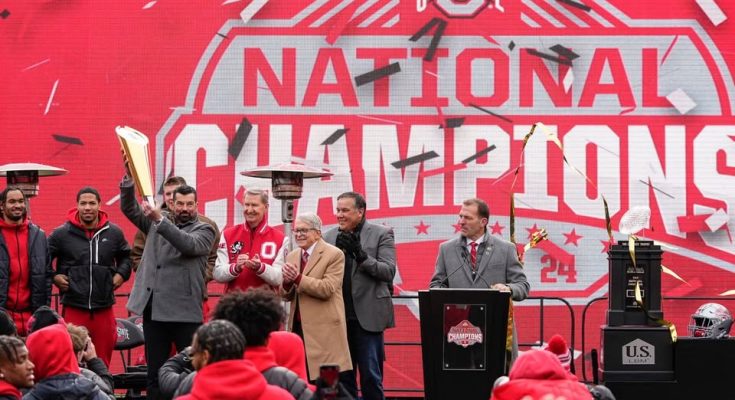Ohio State stands alone among major college football programs for its consistent success, a program that has managed to maintain its dominance through shifting eras, changes in coaching philosophies, fluctuations in recruiting landscapes, and the ever-changing culture of college athletics. While other schools have had flashes of greatness—periods where they ruled the sport before fading into mediocrity or rebuilding cycles—the Buckeyes have represented a near-constant presence at the top of the college football mountain. They have been able to achieve this not simply because of one factor but through a blend of culture, geography, resources, and institutional commitment that has kept the scarlet and gray relevant in ways that very few programs can match.
To understand Ohio State’s success decade after decade, one must first look at the historical context. Unlike many other programs that have risen and fallen, Ohio State has been building its tradition steadily since the early 20th century. The groundwork was laid long before the modern television era gave programs national visibility. The Buckeyes established themselves as a power in the Big Ten during the 1940s under Paul Brown and then further cemented their identity under Woody Hayes, who became the face of Ohio State football and created an expectation that success was the standard, not the exception. Hayes’ tenure is remembered for its toughness, discipline, and relentless recruiting within the fertile grounds of Ohio and surrounding regions. More importantly, Hayes created a culture in which excellence was demanded and mediocrity was unacceptable. This is the cultural foundation that carried over long after his departure.
The geographic advantage Ohio State enjoys is another pillar of its success. The state of Ohio is one of the most talent-rich states in the country for high school football, regularly producing dozens of Division I players each year. More importantly, Ohio produces athletes with a particular kind of football mentality—tough, fundamentally sound, and committed to the sport in a way that resonates with the program’s identity. Unlike some other states where talent is spread thin among many in-state powerhouses, Ohio State has long been the clear dominant program within its own borders. Michigan, Penn State, and Notre Dame have historically recruited Ohio well, but the Buckeyes have always had the advantage of being the flagship program of the state, which means that the majority of elite Ohio prospects grow up dreaming of wearing scarlet and gray. This creates a natural recruiting pipeline that has been sustained over decades, ensuring that even in years where national recruiting becomes more competitive, Ohio State rarely misses out on homegrown stars.
Another factor that cannot be ignored is Ohio State’s ability to adapt while still holding onto tradition. In college football, programs that fail to evolve often fall behind, even if they once dominated. Ohio State has been remarkably successful in modernizing its program whenever the sport demanded it. Under Woody Hayes, the program was built on power football and defense. Under Earle Bruce and John Cooper, the emphasis shifted toward incorporating a more modern passing game, even if Cooper struggled in rivalry games. Then Jim Tressel came along in the early 2000s and created a more balanced, disciplined approach, one that brought Ohio State a national championship in 2002 and kept the Buckeyes as a perennial contender. Urban Meyer took it even further, recognizing the rise of spread offenses and the necessity of recruiting speed and athleticism at every position. His national title in 2014 proved that Ohio State could adapt to the new age of college football. And now, under Ryan Day, the program has doubled down on offensive firepower, producing NFL-ready quarterbacks and wide receivers at a rate unmatched by any other school.
Recruiting is perhaps the clearest reflection of Ohio State’s enduring strength. While many programs rely on peaks and valleys, Ohio State is one of the few schools that consistently recruits at an elite level every single year. Recruiting rankings consistently place the Buckeyes within the top five or ten nationally, and this is not by accident. Ohio State’s brand sells itself to recruits. The program offers a direct path to the NFL, as evidenced by the countless first-round picks who come through Columbus. It offers a tradition of winning that few schools can match, which appeals to competitive athletes who want to play for championships. And it offers an alumni base and fan support that create an unparalleled atmosphere. Few programs can sell all three of these factors as effectively as Ohio State can, and this is why it remains competitive for nearly every major prospect, whether from Ohio, the South, the West Coast, or beyond.
Institutional commitment also plays a massive role. Ohio State treats football as its crown jewel, and the university ensures that the program has the resources to compete at the highest level. Facilities are state-of-the-art, and constant investments are made to stay ahead of competitors. The athletic department prioritizes football revenue in ways that strengthen recruiting and national branding. Beyond facilities, the school’s ability to attract and retain top-tier coaching talent is unmatched. When a coach leaves or is forced out, Ohio State rarely takes a step back, instead making bold hires that keep the program aligned with modern trends. Unlike other schools that allow sentiment or hesitation to dictate decisions, Ohio State has consistently shown a willingness to do what it takes to stay relevant, and this has made them a model of consistency.
The culture within the program is another defining element of its success. Ohio State’s players grow up knowing the weight of wearing the scarlet and gray, understanding the historical significance of the program, and feeling the responsibility to uphold its standards. This cultural buy-in is especially visible in the rivalry with Michigan, where the game is treated not just as another contest but as a defining element of the season. Coaches from Hayes to Tressel to Meyer and Day have all emphasized this rivalry as central to the program’s identity, which helps maintain intensity and focus year after year. Rivalries can tear programs apart when they become lopsided, but in Ohio State’s case, dominance over Michigan in recent decades has only reinforced the program’s national standing.
Perhaps most importantly, Ohio State has managed to avoid long stretches of irrelevance because it never allows losing to become acceptable. Programs like Texas, USC, and Miami have all had stretches of greatness but then fell into long rebuilding phases due to poor hires, mismanagement, or complacency. Ohio State, however, has an institutional intolerance for mediocrity. Even in down years, the Buckeyes remain competitive enough to win nine or ten games, which prevents the program from falling too far behind its competitors. This ability to sustain a high floor, even during transitions, ensures that Ohio State is always just a few adjustments away from being in championship contention.
Another underappreciated element of Ohio State’s success is its ability to produce NFL talent, which perpetuates the cycle of recruiting and prestige. Few programs can match the Buckeyes when it comes to placing players in the professional ranks. Quarterbacks, running backs, wide receivers, offensive linemen, and defensive backs alike have all thrived at Ohio State before becoming high draft picks. This not only appeals to recruits but also creates an aura of professionalism around the program. Young athletes see Ohio State as a place where they can develop and prepare for the highest levels of football. And once those athletes succeed in the NFL, they often return to support the program, donating money, mentoring current players, and continuing the cycle of success.
The fan base also contributes significantly to Ohio State’s sustained dominance. Few programs in the country can match the size, loyalty, and passion of Buckeye Nation. Every Saturday, Ohio Stadium is filled with over 100,000 fans, creating an intimidating environment for opponents and an unforgettable experience for recruits. Beyond the stadium, the national presence of Ohio State fans ensures that no matter where the Buckeyes play, they are supported by a massive contingent of fans. This type of national following keeps the program relevant in the media, enhances its brand, and makes it easier to recruit nationally. The cultural importance of Ohio State football within the state of Ohio also means that the program is deeply woven into the identity of its fans, giving it a level of support that transcends wins and losses.
Finally, Ohio State’s adaptability to external changes in the sport has kept it consistently ahead. When television deals changed the economics of college football, Ohio State embraced the national exposure. When conference realignment reshaped the sport, Ohio State remained a central pillar of the Big Ten and positioned itself as the conference’s flagship program. When the College Football Playoff system arrived, Ohio State immediately became one of the schools best suited to compete on that stage. Now, as the sport continues to evolve with NIL and transfer portal changes, Ohio State has positioned itself as a program that can leverage these new dynamics to its advantage, rather than falling behind.
In the end, Ohio State’s decades of success can be attributed to the rare combination of history, geography, recruiting, institutional support, culture, adaptability, and fan engagement. While many programs may have one or two of these elements, very few have all of them working together in harmony. Ohio State does. And that is why, decade after decade, the Buckeyes not only remain relevant but also thrive at the very top of the college football world. Their formula is not built on chance or temporary bursts of greatness; it is a carefully cultivated system that ensures consistency and resilience. For as long as the program continues to embrace these values, Ohio State will stand alone as the model of consistency in major college football.



